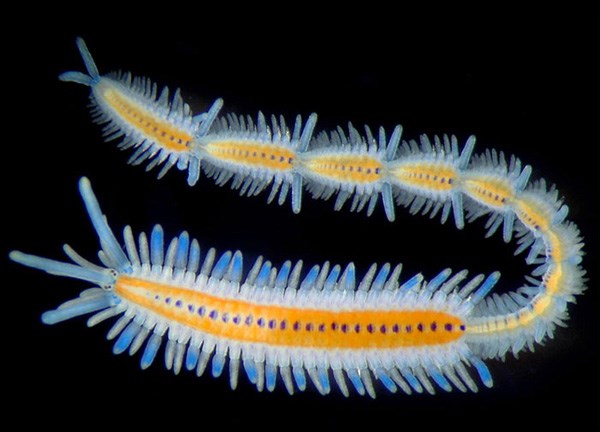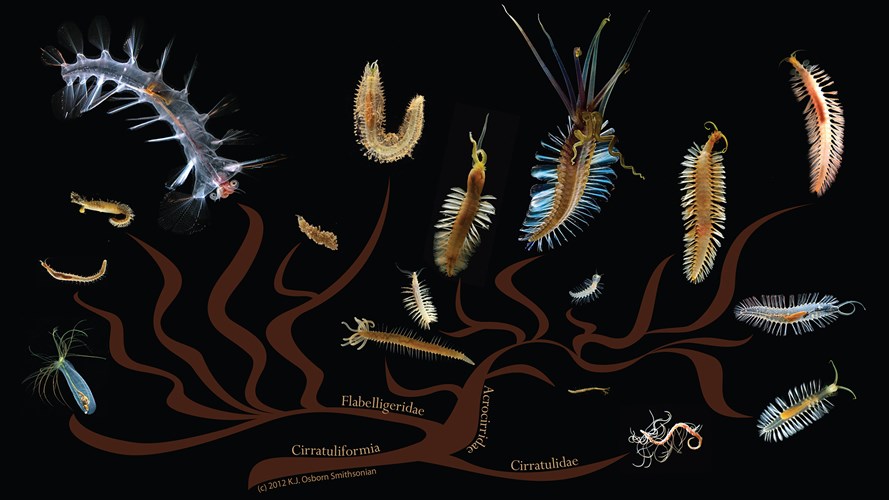The most diverse worm species on the ocean floor
With over 10,000 different species on the ocean floor, many silk worms become champions of species diversity. This strange creature has survived the greatest extinction of the planet.
Unexpected discovery of the most diverse worms on the ocean floor
Thanks to a simple body composition (including head, tail and burning body), polychaete worms become champions of species diversity. The limbs of this strange creature may be like a paddle to swim or like a foot to walk or spoon-shaped to dig a cave.
The body has hard hair that makes it difficult for the enemy to swallow, even some species have venom. Archaeologists have discovered fossils of Canadia and Burgessochaeta worms in Burgess Shale dating to 505 million years ago, during the Cambrian period.

Polychaete earthworms are unidentified creatures of species diversity
This proves that these tiny polychaete worms have survived the greatest extinction of the planet. Polychaete worm has now grown into 10,000 different species and that is only the number of scientists known for over 500 million years. This makes scientists great efforts to arrange and describe how species follow a system.
Pompeii worm (scientific name Alvinella pompejana) can live for half a day at the hydrothermal vents deep in the ocean floor - where temperatures reach 60 degrees C. Most polychaete species reproduce by ejaculation coincides and eggs enter the water and leave them to fertilize themselves.

Scientists knew of this strange creature 500 million years ago
Methane hydrate is a form of methane trapped in a water crystal structure, forming a solid like ice that makes no microorganism live inside, except the Hesiocaeca methanicola polychaete. They can survive up to 96 hours without oxygen to breathe.
Colorful colorful Christmas tree worms are also a species of polychaete family. When in danger, they pulled the fur hat like a Christmas tree to the coral reef and waited until the danger of new passage "expanded" again.

Worms and glowing Christmas trees
In the silkworm family, there are 5 species of worms known as zoombie worms (Osedax sp.) Because of their interest in eating decayed animal bones, mainly whale bones. They do not have a mouth or stomach that attaches roots to bones to suck in fat and protein buried inside.
Most polychaete worms are small animals, but the Bobbit worm (Eunice Aphroditois) is an exception. Their body length can be up to 3m along with extremely unique bait-catching skills.

Worms zoombie eat whale bones
About 400 species of polychaete have a close relationship with vertebrates. Typically, Arctonoe vittat is found while living with more than 30 different species of invertebrates, including starfish.
Recently, a team of American scientists recently discovered a strange creature that lies 1,100 meters deep beneath the surface of the Earth, in a deep wet cave in the mountain of Velebit in northwestern Croatia. Experts named this centipede is Geophilus Hadesi - the name of a god in Greek mythology.

Strange creatures are located 1100 meters below the surface of the Earth
- Explore the ocean
- Video: The scenery on the ocean floor if the water is dry
- The 10 most shocking mysteries of the ocean floor
- New strange creatures are found on the deep ocean floor
- Mysterious long crab species by car in the Pacific Ocean
- Discover some new species of worms in the ocean
- Detecting strange footprints near the ocean surface nearly 4km
- Explore the ocean with high technology
- 10 giant animals on the ocean floor
- Discover the world's most peculiar worm
- Bizarre creatures hiding in the deep sea
- Startled, this swimmer banana is a god of death at the bottom of the ocean
 Surprised: Fish that live in the dark ocean still see colors
Surprised: Fish that live in the dark ocean still see colors Japan suddenly caught the creature that caused the earthquake in the legend
Japan suddenly caught the creature that caused the earthquake in the legend A series of gray whale carcasses washed ashore on California's coast
A series of gray whale carcasses washed ashore on California's coast Compare the size of shark species in the world
Compare the size of shark species in the world Four new species appear as 'hybrids' of extraterrestrial creatures
Four new species appear as 'hybrids' of extraterrestrial creatures  Strange species in Southeast Asia becomes the first marine fish species 'extinct due to humans'
Strange species in Southeast Asia becomes the first marine fish species 'extinct due to humans'  Ancient humans may still live on Indonesia's Flores island
Ancient humans may still live on Indonesia's Flores island  The 'dragon' species that was thought to only exist in myths is one of the rarest on the planet.
The 'dragon' species that was thought to only exist in myths is one of the rarest on the planet.  How many animals have ever existed on Earth?
How many animals have ever existed on Earth?  Treasure of Southeast Asia: Rare animal species found in only 9 countries in the world, Vietnam just received good news!
Treasure of Southeast Asia: Rare animal species found in only 9 countries in the world, Vietnam just received good news! 